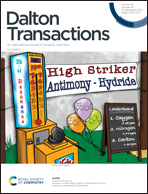Unexpected photoactivation pathways in a folate-receptor-targeted trans-diazido Pt(iv) anticancer pro-drug†
Abstract
A conjugate between a photoactive trans-diazido Pt(IV) pro-drug, trans,trans,trans-[Pt(N3)2(OH)2(py)2], and folic acid has been synthesized and fully characterized by high resolution ESI-MS, NMR and UV-vis spectroscopy. Photoactivation of the Pt–folate conjugate with visible light confirmed the generation of cytotoxic Pt(II) species capable of binding to guanine nucleobases. Importantly, photoreduction of the Pt(IV) complex triggered the photodecomposition of the folate vector into a p-aminobenzoate-containing fragment and several pterin derivatives, including 6-formylpterin. Besides exhibiting high dark stability in physiological-like conditions, the Pt–folate conjugate was ca. 2× more photocytotoxic towards MCF-7 breast cancer cell line than its parent Pt(IV) complex with a high photoselectivity index (PI > 6.9). The higher photocytotoxicity of the conjugate may be a consequence of its higher cellular accumulation and of the generation of a set of different cytotoxic species, including Pt(II) photoproducts and several pterin derivatives, which are known to generate ROS.



 Please wait while we load your content...
Please wait while we load your content...